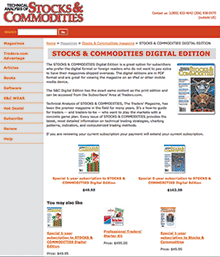Letters To The Editor
August 2011 Letters To The Editor
The editors of S&C invite readers to submit their opinions and information on subjects relating to technical analysis and this magazine. This column is our means of communication with our readers. Is there something you would like to know more (or less) about? Tell us about it. Without a source of new ideas and subjects coming from our readers, this magazine would not exist.
Address your correspondence to: Editor, Stocks & Commodities, 4757 California Ave. SW, Seattle, WA 98116-4499, or E-mail to editor@traders.com. All letters become the property of Technical Analysis, Inc. Letter-writers must include their full name and address for verification. Letters may be edited for length or clarity. The opinions expressed in this column do not necessarily represent those of the magazine. —Editor
INTERVIEW WITH MARCUS HEITKOETTER
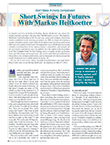 Editor,
Editor,
In your recent interview with Marcus Heitkoetter (“Short Swings In Futures With Markus Heitkoetter,” May 2011), I noticed that when he was discussing the Bollinger Bands adjustment for the moving average, he suggests lowering the number of bars in the moving average. Then, however, the article goes on to say he adjusts them from nine to 12.
Is this a typo? It seems that he is increasing the number of bars rather than decreasing them.
Thanks for your response. The interview was another good one.
Jmr
It is a typo. It should have read, “You should shorten the number of bars used in the moving average to something between 9 and 12.”
Heitkoetter goes on to say that he prefers to use a setting of 12 for the standard moving average.—Editor
GAP FILL AND GO TRADE SETUPS
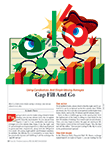 Editor,
Editor,
I found Jamie Theiss’ article (“Gap Fill And Go,” May 2011) quite interesting. Can he advise how he scans to find his trade candidates and determine which ones to trade?
Does he use this strategy in forex?
James
Author Jamie Theiss replies:
I have a watchlist of only 20 stocks and only eight to 12 that I watch closely and actually trade most days. I used to use a scanner but got far too many junk alerts even with the limits I programmed in, so I was running and chasing too much. So I took Jesse Livermore’s advice when he said it is better to watch too few than too many.
My criteria for candidates is a volume of at least a million shares per day; most are three million or more — securities like Sndk, Rimm, Qcom, Qqq, Fas, Faz, Jpm, Wfc, Slv, and Abx. Other possibilities include X, Xom, Hal, Mos, Anf, Cost.
So, as you can see, I have most sectors covered, and there will always be some sector moving so that I can get a setup.
As for forex: I don’t daytrade forex, only swing trade it. I do use this and other similar strategies, but on the higher time frame charts like the 15- and 60-minute charts for entries and the daily chart for setups. I use just the 20-day Sma for swing trades and drop the eight-day Sma as well.
MORE ON GAP FILL AND GO TRADE SETUPS
Editor,
I am trying to be a full-time trader and was really inspired by Jamie Theiss’ excellent article in the May 2011 issue. I was wondering if he could help me figure out how to find these trades. I am able to pull up a list of stocks that have gapped up, but it seems very difficult to find the few that are pulling back to fill the gap and beginning to reverse.
Does he have a method that he would like to share for finding these stocks in the morning, or does he have some sort of filtering criteria?
Marty
Author Jamie Theiss replies:
Being a full-time trader is great, but don’t expect it to come easy. It will probably take longer than you think. Time, cost, pain, and frustration are what await you.
While setups are important, it’s what you do after you enter the market that is most important.
There are two ways to trade: Either become a master at one strategy and apply it to a wide number of stocks, or become a master of a limited number of stocks and apply several different strategies to those few securities. There are pros and cons to both ways. Be aware that not all days will be tradable using either method. So some days you do nothing.
I use more than one strategy on the small number of stocks I trade, but it is all just a variation of the strategy I wrote about in my article.
For example, today [May 6, 2011] I traded the Qqq. The variation I used today was that I was going to short the gap up. But it ran up a few five-minute bars before reversing. I waited and shorted the five-minute topping tail and expected it to pull back to the moving averages and set up for a long. It didn’t really pull back as far as I was expecting, but I covered enough to make my daily goal on that short alone. It then put in a buy setup similar to what I wrote about in my article. I went long and made another daily goal.
Finally, if you don’t have a written trading plan with exact if–then scenarios for your entry, exit, and other trade-management issues, then you are sunk before you even begin. Before you even enter the market, you need to have all these questions answered.
DAYTRADING ADVICE
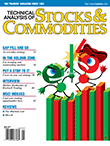 Editor,
Editor,
I read Jamie Theiss’ article “Gap Fill and Go” in the May 2011 S&C. As a novice trader, I would like to know if there are any good books that are a must-read that will help me daytrade stocks and the S&P 500?
Keisha Brooks
Author Jamie Theiss replies:
The book Tools And Tactics For The Master Day Trader by Oliver Velez is gold. The first two pages of the first chapter tell you all you need to know (but you won’t believe it until you experience it!). The first half of the book is where all the answers are. The back half is a bit dated regarding setups but is still good.
Here are some more book recommendations:
- Trading In The Zone by Mark Douglas
- Anything by Van K. Tharp
- Anything by or about Jesse Livermore
Remember, while setups and entries are important, they are the least important. It is what you do after you enter the trade that counts. It is all mental.
It doesn’t matter what your technique is — moving averages, Bollinger Bands, Fibonacci retracements, candlesticks, and so on. Just use it consistently in accordance with your written trading plan. If you don’t have a written trading plan, you are sunk before you begin. (Please read that sentence again!)
The acid test for a properly written trading plan is to give it to someone else and see if they can trade it just as you would have. If they can’t, there may be holes in it and you’ll need to tighten it up.
CHANNELS IN THE FOREX MARKETS
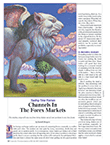 Editor,
Editor,
I want to thank author Gareth Burgess for his contributions to Stocks & Commodities magazine (“Forex Entry,” October 2010, and “Channels In The Forex Markets,” March 2011), as I am an avid reader and enjoy input from real traders.
I am very interested in the three-point touch method discussed in “Channels In The Forex Markets” to help keep me in stocks when the market is in a consolidation phase, and I believe this method will really help. I have a question:
In the example given in the article, regarding points 1 and 3 (reaction lows) before they are established, I am guessing that this cannot be based on a close, such as the preceding candlestick. Does a “tail” have to be established and close above the tail?
Brian
Author Gareth Burgess replies:
I have no criteria. I am simply looking for the lows, regardless of the candlestick type. As with many aspects of charting, such as pivot level, these reaction points really only come into play after they are established. So if you have missed the beginning of the channel, there will be other opportunities later by trading up out of the channel or back toward to the channel, and so on.
FOREX ENTRY
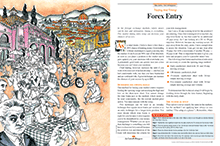 Editor,
Editor,
In Gareth Burgess’ October 2010 article (“Forex Entry”), he states that we should use the New York close to derive the opening range price. Is that only for Usd pairs, or is it generic for all pairs? Is it based on the Acd method by Mark Fisher?
Eddie
Author Gareth Burgess replies:
The interbanks are responsible for the core of forex buying/selling. The New York close for European bank spot traders is officially 22:00 Gmt. A close is a close, regardless of the currency going through!
The market is very active between 06:00 Gmt and 22:00 Gmt. Creating an opening range gives you an edge on the market direction. This is very useful for trading your bias, short term or long term. You can mirror the opening range, for example, with Eur/Usd and Usd /Chf.
Mark Fisher uses the opening range taken from the European opening. My opinion is that the market is 24 hours; therefore, applying two hours and not 30 minutes has a stronger definition, especially if it is established at a time where the market is not being pushed around by the main banks! When they begin putting orders through and the market moves away from the opening range, you have your bias.
Fisher also applies a pivot range calculated from the previous high/close/low — again, very useful for directional purposes and establishing support/resistance (S/R) levels, and also for creating moving averages based on the pivot levels. Plus, he uses a rolling pivot level to help maintain positions, but I do not use all of his methods. Instead, I apply the 34-period moving average on short-term charts and 10- and 30-period MAs on the daily. Fisher’s book (The Logical Trader, John Wiley & Sons, 2002) is one that is worth reading!
Keep in mind that these technical aspects are there to help create a directional bias. It is the actual process of trading — that is, price watching at levels of S/R — not technical analysis itself that makes money!
K-WAVE AND BEYOND
Editor,
I appreciate the depth of Koos van der Merwe’s article in the April 2011 issue of S&C (“Today’s K-Wave And Beyond”). Does he have a website where I can see an update of his annotated S&P chart?
I’d like to read more of his work — please point me in the right direction.
Dusty Field
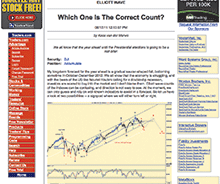
Author Koos van der Merwe replies:
You can see more of my work in the online publication Traders.com Advantage at Traders.com, by the same publisher as this magazine.
S&C DIGITAL VERSION COMMENTS
Editor,
Is your digital edition available for download and offline reading, or just online?
Robert
You download the digital version as a Pdf file and read it offline.—Editor
Editor,
In the case of the digital edition, will I be able to print any article that may be of interest for me to keep?
Vasant Kumar
Yes, you can print any page from the downloaded Pdf file.—Editor
Editor,
I have been a customer for many years — I actually do still have your very first issue. I have been waiting for you to have a digital subscription. Thanks!
John Yde
Denmark
